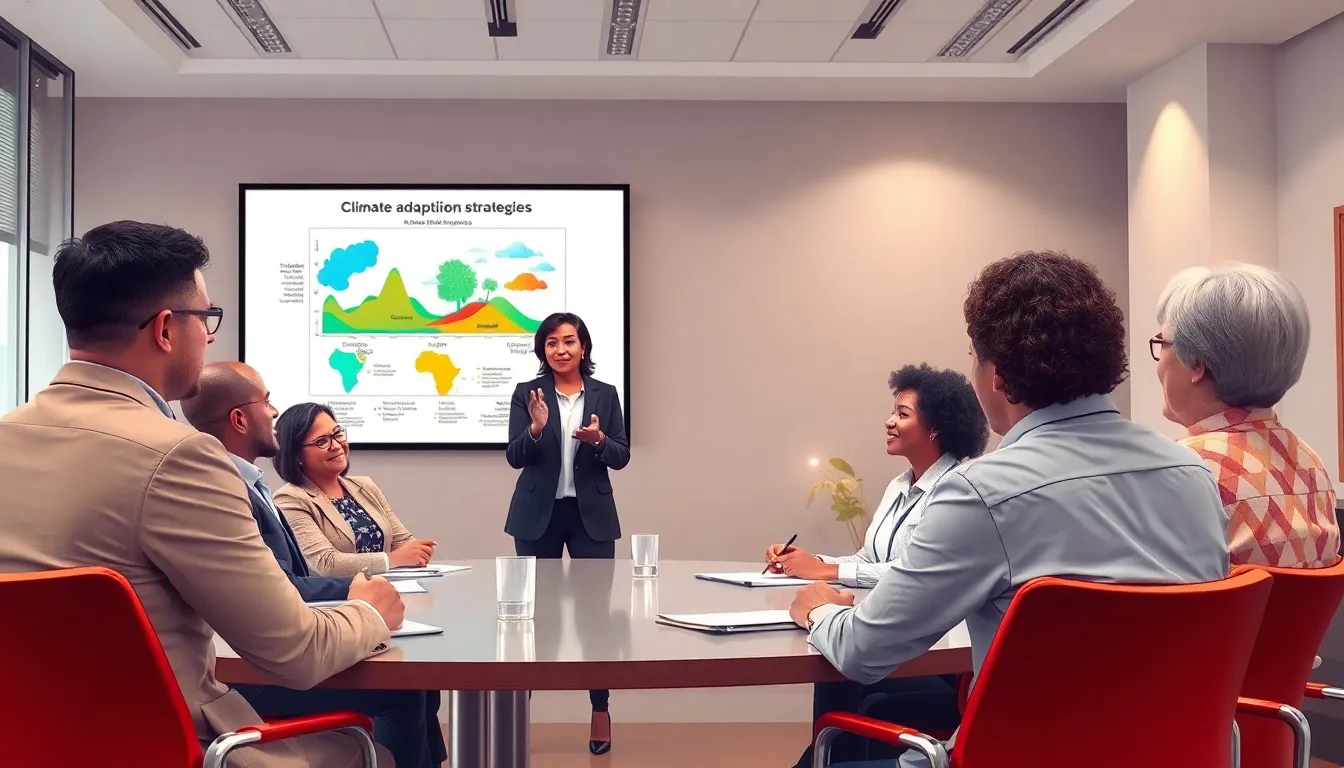In a world that changes faster than a cat video goes viral, adaptation in policy isn’t just a buzzword—it’s a necessity. Governments and organizations must keep pace with emerging challenges, whether it’s climate change, technological advancements, or the latest social trends. Think of it as a dance; if policymakers can’t keep their feet moving, they’ll step on their own toes and trip over the competition.
Table of Contents
ToggleOverview of Adaptation in Policy
Adaptation in policy refers to the ability of governments and organizations to respond effectively to evolving circumstances. Policymakers must remain flexible when addressing significant challenges.
Definition and Importance
Adaptation involves adjusting policies to meet new realities. It’s crucial because it enhances resilience against issues like climate change and technological disruptions. By adapting, leaders can implement proactive measures. Policymakers benefit from understanding the specific needs of their communities. Enhanced adaptability leads to more effective governance, enabling societies to thrive despite uncertainties, while promoting sustainable development.
Historical Context
Historically, adaptation in policy emerged from the need to navigate crises. In the late 20th century, governments faced globalization and environmental degradation. Policies began focusing on sustainability, recognizing the interconnectedness of global challenges. The 1992 Earth Summit highlighted climate change as a critical issue, prompting international cooperation. Today, understanding past adaptation efforts informs current strategies. Policymakers analyze historical responses to develop frameworks that address both ongoing and future challenges effectively.
Key Drivers of Adaptation in Policy

Adaptation in policy is influenced by several key drivers that necessitate timely responses to changing conditions.
Climate Change Impacts
Climate change presents significant challenges for policymakers. Rising temperatures and extreme weather events demand proactive strategies. Evidence shows that adapting infrastructure to withstand climate impacts can mitigate damage costs, with investments in resilience yielding long-term savings. Flooding, droughts, and heatwaves intensify the need for adaptive measures. Policymakers must prioritize climate resilience in urban planning to address these threats effectively. Communities that adapt will better protect their populations and economies against inevitable climate disruptions.
Socioeconomic Factors
Socioeconomic conditions heavily influence policy adaptation. Economic disparities can dictate the resources available for implementing adaptive strategies. Vulnerable populations often face greater risks from climate impacts, emphasizing the need for equitable adaptation efforts. Access to education and technology plays a crucial role in how communities respond to challenges. Policies that promote inclusive growth and sustainability can enhance resilience across diverse socioeconomic groups. Comprehensive approaches consider local contexts and prioritize marginalized communities in adaptation planning.
Strategies for Effective Adaptation in Policy
Effective adaptation in policy involves utilizing strategies that enhance responsiveness and resilience. Collaborative efforts and evidence-based approaches serve as essential components in this process.
Collaborative Approaches
Working together is crucial for effective policy adaptation. Different stakeholders, including governments, non-profits, and local communities, must engage in dialogue to understand diverse perspectives. Partnerships can facilitate resource sharing and expertise. Engaging communities in decision-making leads to more tailored solutions which address specific regional challenges. Local knowledge often provides insights that data alone cannot capture. Furthermore, collaboration fosters trust, ensuring that policy implementation considers the needs of all affected parties.
Evidence-Based Decision Making
Relying on solid data is fundamental for informed policy adaptation. Policymakers must gather quantitative and qualitative evidence from scientific research and case studies to guide their strategies. Identifying trends and evaluating past outcomes helps in forecasting future challenges. Incorporating local data allows for context-specific adaptations that resonate with the community. Moreover, employing metrics to track progress enhances accountability and encourages ongoing adjustments to strategies as new information arises. Prioritizing evidence-based approaches builds a framework for sustainable and effective policy responses.
Case Studies of Adaptation in Policy
Numerous case studies illustrate effective adaptation in policy, showcasing how governments and organizations confront new challenges.
Successful Examples
City planners in Rotterdam implemented innovative water management strategies to combat rising sea levels. The approach includes building floating structures and enhancing green roofs to absorb rainfall. In California, officials adapted wildfire management policies by increasing funding for prevention and community education programs. These changes significantly reduced the incidence of uncontrolled wildfires. In Finland, the National Climate Change Adaptation Strategy prioritizes biodiversity and ecosystem services, ensuring natural systems remain resilient to climate impacts. Together, these successful examples demonstrate proactive policy adaptations addressing critical environmental challenges.
Lessons Learned
Stakeholder engagement emerges as a crucial lesson in policy adaptation. Policymakers benefit from involving community members and local organizations in the decision-making process. This engagement leads to tailored solutions that reflect specific regional needs. Evidence-based approaches prove essential for understanding complex issues and formulating effective strategies. Robust data collection not only informs policies but also builds credibility among stakeholders. Dedicating resources to continuous learning enhances adaptability and resilience in policy frameworks. Such lessons underscore the importance of flexibility, collaboration, and informed decision-making in addressing emerging challenges.
Challenges and Barriers
Adaptation in policy faces several challenges that hinder effective implementation. Institutional constraints often limit flexibility in decision-making processes or resource allocation.
Institutional Constraints
Bureaucratic inertia can slow down the adoption of new policies. Regulations may restrict innovative solutions, forcing policymakers to adhere to outdated practices. Resource availability often dictates the speed and scope of adaptation efforts. Funding limitations create further barriers, constraining the implementation of necessary changes. Each layer of bureaucracy may require extensive approvals, delaying timely responses to emerging challenges. Collaboration across different government levels becomes complicated, often leading to miscommunication and inefficiency.
Public Perception
Public perception significantly impacts the success of adaptive policy measures. Misinformation can lead to skepticism about the necessity of adaptation efforts. Trust in government organizations plays a critical role in public acceptance of innovative policies. Communities must understand the potential benefits of adaptation strategies for active participation. Engaging the public through outreach and education builds support for resilience initiatives. Negative sentiments can quickly undermine efforts if stakeholders feel excluded from the decision-making process. Effective communication fosters a shared vision, enhancing the likelihood of successful adaptation in policies.
Adaptation in policy is no longer a choice; it’s a necessity for governments and organizations facing a rapidly changing landscape. The ability to pivot in response to emerging challenges determines resilience and success. By prioritizing collaboration and evidence-based strategies, policymakers can craft solutions that resonate with their communities.
Investing in adaptive measures not only addresses immediate concerns but also lays the groundwork for a sustainable future. As the world continues to evolve, those who embrace flexibility and engage stakeholders will lead the way in effective policy adaptation. The lessons learned from past efforts will guide future strategies, ensuring that communities remain resilient in the face of uncertainty.


